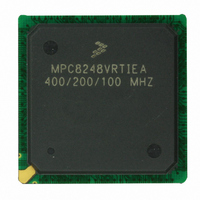MPC8248VRTIEA Freescale Semiconductor, MPC8248VRTIEA Datasheet - Page 13

MPC8248VRTIEA
Manufacturer Part Number
MPC8248VRTIEA
Description
IC MPU POWERQUICC II 516-PBGA
Manufacturer
Freescale Semiconductor
Datasheet
1.MPC8248VRMIBA.pdf
(60 pages)
Specifications of MPC8248VRTIEA
Processor Type
MPC82xx PowerQUICC II 32-bit
Speed
400MHz
Voltage
1.5V
Mounting Type
Surface Mount
Package / Case
516-PBGA
Family Name
MPC82XX
Device Core
PowerQUICC II
Device Core Size
32b
Frequency (max)
400MHz
Instruction Set Architecture
RISC
Supply Voltage 1 (typ)
1.5V
Operating Supply Voltage (max)
1.575V
Operating Supply Voltage (min)
1.425V
Operating Temp Range
0C to 105C
Operating Temperature Classification
Commercial
Mounting
Surface Mount
Pin Count
516
Package Type
TEPBGA
For Use With
CWH-PPC-8248N-VE - KIT EVAL SYSTEM QUICCSTART 8248
Lead Free Status / RoHS Status
Lead free / RoHS Compliant
Features
-
Lead Free Status / Rohs Status
Compliant
Available stocks
Company
Part Number
Manufacturer
Quantity
Price
Company:
Part Number:
MPC8248VRTIEA
Manufacturer:
Freescale Semiconductor
Quantity:
10 000
Part Number:
MPC8248VRTIEA
Manufacturer:
FREESCALE
Quantity:
20 000
where:
R
affect the case-to-ambient thermal resistance, R
the device, add a heat sink, change the mounting arrangement on the printed circuit board, or change the
thermal dissipation on the printed circuit board surrounding the device. This thermal model is most useful
for ceramic packages with heat sinks where some 90% of the heat flows through the case and the heat sink
to the ambient environment. For most packages, a better model is required.
4.3
A simple package thermal model which has demonstrated reasonable accuracy (about 20%) is a
two-resistor model consisting of a junction-to-board and a junction-to-case thermal resistance. The
junction-to-case thermal resistance covers the situation where a heat sink is used or where a substantial
amount of heat is dissipated from the top of the package. The junction-to-board thermal resistance
describes the thermal performance when most of the heat is conducted to the printed circuit board. It has
been observed that the thermal performance of most plastic packages, especially PBGA packages, is
strongly dependent on the board temperature.
If the board temperature is known, an estimate of the junction temperature in the environment can be made
using the following equation:
where:
If the board temperature is known and the heat loss from the package case to the air can be ignored,
acceptable predictions of junction temperature can be made. For this method to work, the board and board
mounting must be similar to the test board used to determine the junction-to-board thermal resistance,
namely a 2s2p (board with a power and a ground plane) and by attaching the thermal balls to the ground
plane.
4.4
When the board temperature is not known, a thermal simulation of the application is needed. The simple
two-resistor model can be used with the thermal simulation of the application, or a more accurate and
complex model of the package can be used in the thermal simulation.
Freescale Semiconductor
θJC
is device related and cannot be influenced by the user. The user adjusts the thermal environment to
R
R
R
R
T
P
D
B
θJA
θJC
θCA
θJB
Estimation with Junction-to-Board Thermal Resistance
Estimation Using Simulation
= board temperature (ºC)
= power dissipation in package
= junction-to-case thermal resistance (ºC/W)
= junction-to-board thermal resistance (ºC/W)
= junction-to-ambient thermal resistance (ºC/W)
= case-to-ambient thermal resistance (ºC/W)
R
T
θJA
J
= T
= R
B
+ (R
MPC8272 PowerQUICC II™ Family Hardware Specifications, Rev. 2
θJC
θJB
+ R
θCA
× P
D
)
θCA
. For instance, the user can change the air flow around
Thermal Characteristics
13











